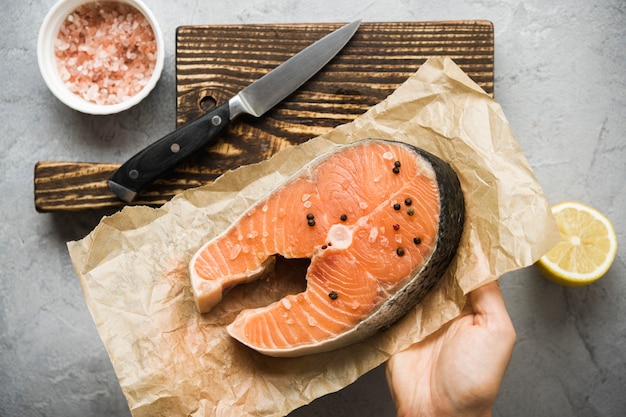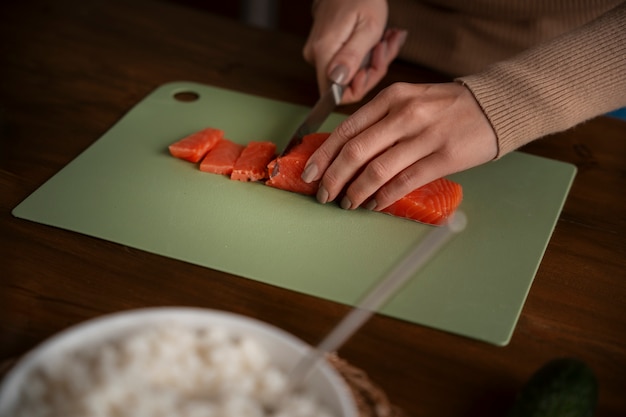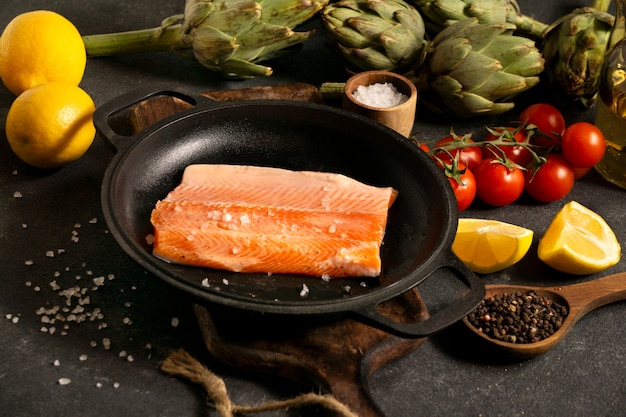Right, let's talk salmon. It's a personal favourite of mine, and honestly, it's pretty easy to cook, even if you're a bit of a kitchen novice. Now, you've probably heard it a million times: "Salmon is best cooked at 400 degrees." And it's true, that's the sweet spot for getting that lovely, flaky texture and a gorgeous, golden crust.
But here's the thing – just throwing your salmon into the oven at 400 degrees and hoping for the best isn't going to cut it. It's all about knowing exactly how long to cook it, and that's where this guide comes in. I'm going to break down everything you need to know, from prepping your salmon to getting it perfectly cooked every time. I'll even share some of my own tips and tricks that I've learned over the years.
(Part 1) Prepping Your Salmon for the Oven

So, you've got your salmon – fantastic! But before we even think about the oven, let's get it prepped right. This is the foundation for a delicious salmon dinner, so don't skip it!
choosing the right salmon
You can't go wrong with fresh salmon, especially if you're lucky enough to have a good fishmonger nearby. But frozen salmon is totally fine too. Just make sure it's thawed properly before you get started. I usually defrost mine in the fridge overnight, which gives it time to thaw out slowly and evenly. This helps to prevent the fish from becoming watery.
Now, when it comes to types of salmon, there's a whole world out there! From the classic atlantic salmon to the more adventurous Sockeye, each variety has its own distinct flavour and texture. I personally prefer the richness of wild-caught salmon, but farmed salmon is a great option too, especially if you're looking for a more affordable choice.
Skin On or Skin Off?
This is a bit of a personal preference, really. I love the crispy skin that you get when you cook salmon with the skin on. It adds a fantastic textural element and also helps to lock in moisture. But, if you're not a fan, you can definitely remove it. Just make sure to score the skin a few times to prevent it from curling up during cooking. If you're removing the skin, you can always add a little extra flavour by brushing the salmon with some olive oil and herbs before baking.
Seasoning Your Salmon
This is where you can really get creative! I'm a big fan of simple seasoning – a good pinch of salt and pepper usually does the trick. But if you want to get fancy, you can try things like lemon zest, garlic powder, or even a drizzle of honey.
Here are a few of my go-to salmon seasoning combinations:
Citrus Burst: A sprinkle of lemon zest, a pinch of salt and pepper, and a drizzle of olive oil.
Herby Delight: Fresh herbs like dill, parsley, or rosemary, a dash of salt and pepper, and a squeeze of lemon juice.
Spicy Kick: A blend of smoked paprika, cayenne pepper, and garlic powder, with a touch of salt and pepper.
Just remember, a little goes a long way! You can always add more seasoning later, but it's harder to take it away once it's baked in.
The Oil Situation
You're going to want to give your salmon a good drizzle of olive oil. It helps it cook evenly and gives it a nice, golden colour. Olive oil adds a lovely depth of flavour, but you can also use other oils like avocado oil or grapeseed oil. Just make sure to use an oil with a high smoke point, as this will prevent it from burning in the oven.
(Part 2) Setting Up Your Oven

Alright, now that your salmon is ready to go, let's focus on the oven. This is where we can get those perfect results.
Getting the Oven Up to Temperature
Start by preheating your oven to 400 degrees Fahrenheit (200 degrees Celsius). It's important to let the oven heat up fully before putting your salmon in. This ensures even cooking and helps the skin get that lovely crisp.
If you're using a fan-assisted oven, you might need to reduce the temperature by 25 degrees Fahrenheit (10 degrees Celsius). The fan circulates the heat more evenly, so it can cook food faster.
The Baking Dish Dilemma
You can use just about any baking dish, as long as it's oven-safe and big enough for your salmon. I usually go for a simple baking sheet. If you're feeling fancy, a cast iron skillet works really well, too. Just make sure your baking dish is clean and dry before you add your salmon.
Adding a Bit of Flavor
Now, this is where things get interesting! You can add some extra flavor to your salmon by putting a few sprigs of fresh herbs, like rosemary or thyme, on the bottom of your baking dish. Just make sure to give them a little pat with your hands to release some of their flavor. And a little squeeze of lemon juice won't hurt either.
I often like to create a bed of aromatics in the bottom of my baking dish. Simply slice some lemon, onions, and garlic and spread them out on the bottom of the dish. This infuses the salmon with additional flavour as it cooks.
(Part 3) Baking Your Salmon to Perfection

Okay, we're down to the nitty-gritty. This is where we're going to get those perfect results.
Cooking Time is Key
Now, the cooking time for salmon depends on the thickness of your fillets. You'll want to aim for about 10-12 minutes for 1-inch thick fillets. But if your fillets are thicker, you'll need to add a few extra minutes.
Here's a general guideline:
1/2 inch thick: 8-10 minutes
1 inch thick: 10-12 minutes
1 1/2 inches thick: 12-15 minutes
2 inches thick: 15-18 minutes
The doneness test
You can always check if your salmon is cooked by gently pressing the top of the fillet. It should be firm to the touch and flake easily with a fork. You can also use a meat thermometer, which should register at 145 degrees Fahrenheit (63 degrees Celsius). This is the safe internal temperature for salmon, ensuring it's cooked through but doesn't dry out.
The Importance of Internal Temperature
That internal temperature of 145 degrees Fahrenheit (63 degrees Celsius) is key for salmon. It ensures it's cooked through but doesn't dry out. overcooked salmon can be dry and tough, so it's important to check it frequently.
(Part 4) Salmon Baking Time Chart
Here's a quick chart to help you figure out the perfect baking time for your salmon.
| Thickness of Salmon | Baking Time at 400 Degrees |
|---|---|
| 1/2 inch | 8-10 minutes |
| 1 inch | 10-12 minutes |
| 1 1/2 inches | 12-15 minutes |
| 2 inches | 15-18 minutes |
Remember, these are just guidelines. The best way to tell if your salmon is cooked is to use a meat thermometer.
(Part 5) Keeping Your Salmon Moist
Now, here's a little trick to help keep your salmon nice and juicy: You can use a piece of parchment paper or foil to cover it while it's baking. This will help to steam the fish and prevent it from drying out. Just make sure to leave a small gap for steam to escape.
I find that parchment paper works best for this, as it allows a little bit of air circulation. You can also try adding a small amount of water to the bottom of the baking dish. This creates a moist environment that helps to prevent the salmon from drying out.
(Part 6) The Art of Resting
Once your salmon is cooked, don't rush to dig in just yet! Let it rest for a few minutes before serving. This allows the juices to redistribute, resulting in a more tender and flavorful fillet.
I usually let my salmon rest for about 5-10 minutes before serving. This gives the juices time to settle and makes the salmon even more moist and delicious.
(Part 7) Flavorful Finishes
Okay, your salmon is cooked and resting. Now, let's make it really shine!
Lemon and Herbs
A squeeze of lemon juice and a sprinkle of fresh herbs like dill or parsley are classic additions that elevate the flavor of salmon. The acidity of the lemon cuts through the richness of the salmon, while the herbs add a bright and refreshing touch.
Garlic Butter
For a rich and indulgent finish, try drizzling your salmon with garlic butter. You can make this by simply melting butter and adding minced garlic. You can also add other herbs like thyme or rosemary for extra flavour.
Spicy Sauces
If you're feeling adventurous, a drizzle of sriracha or gochujang sauce can add a kick of spice. These sauces can be a bit overpowering, so start with a small amount and adjust to taste. You can also try adding a touch of honey or brown sugar to balance out the heat.
(Part 8) Serving Your Salmon
So, your salmon is cooked to perfection, resting, and dressed to impress. Now, it's time to get it onto the plate!
side dishes Galore
There are so many delicious sides that go perfectly with salmon. Here are a few favorites:
- Roasted vegetables like asparagus, broccoli, or Brussels sprouts. The slightly charred flavour of roasted vegetables complements the rich flavour of salmon beautifully.
- A simple salad with a vinaigrette dressing. The acidity of the vinaigrette helps to cut through the richness of the salmon.
- Creamy mashed potatoes. The creamy texture of mashed potatoes is a perfect contrast to the flaky texture of salmon.
- fluffy rice. Rice is a light and refreshing side that goes well with both simple and more complex salmon dishes.
- A fresh green salad. This adds a bit of brightness and freshness to the meal. I often like to toss my salad with a simple vinaigrette dressing.
Presentation Matters
While taste is paramount, don't underestimate the power of presentation. A well-plated dish can elevate your dining experience. Use a nice serving platter or individual plates, and don't be afraid to add some greenery for a touch of elegance.
(Part 9) leftover salmon? No Problem!
I know, I know, sometimes we cook more than we need. But don't fret – leftovers can be delicious too!
Salmon Salad
Chop up your leftover salmon and toss it with some mayonnaise, chopped celery, onion, and a squeeze of lemon juice. Serve it on bread or crackers for a delightful lunch. You can also add a sprinkle of fresh dill or parsley for extra flavour.
Salmon Pasta
Add your leftover salmon to a creamy pasta sauce. You can also add some spinach or peas for extra flavor and nutrients. I like to use a simple cream sauce made with heavy cream, butter, and Parmesan cheese.
(Part 10) Salmon cooking tips for Beginners
cooking salmon at 400 degrees isn't rocket science, but here are a few tips to make your first attempt a breeze:
- Don't overcrowd your baking sheet. Give your salmon some space to cook evenly. If you're baking multiple salmon fillets, make sure they are not touching each other. This will help them cook evenly and prevent them from steaming.
- Use a non-stick baking sheet for easy cleanup. You can also line your baking sheet with parchment paper or foil to make cleanup even easier. Just make sure to leave a small gap in the paper or foil for steam to escape.
- If you're using skin-on salmon, make sure to score the skin to prevent it from curling up. Use a sharp knife to make a few diagonal cuts across the skin. This will help the skin to cook evenly and prevent it from curling up.
- Check on your salmon a few minutes before the estimated cooking time. It might cook a little faster or slower depending on your oven. It's better to err on the side of undercooking than overcooking, as you can always bake it for a few more minutes if needed.
- Don't overcook it! Overcooked salmon can be dry and tough. Salmon is best when it's cooked to a medium-rare or medium doneness. The fish should be flaky and moist, and the inside should be slightly pink.
(Part 11) FAQs
Let's tackle some common questions about cooking salmon at 400 degrees.
1. What's the difference between grilling salmon and baking salmon?
Grilling salmon will give you a nice char on the outside and a slightly crispier texture. Baking salmon, on the other hand, will result in a more tender and moist fillet.
If you're looking for a more intense flavour, grilling is a great option. But if you prefer a more delicate and moist salmon, baking is the way to go.
2. How do I tell if my salmon is done?
As mentioned earlier, use a meat thermometer to check the internal temperature of the salmon. It should be at least 145 degrees Fahrenheit (63 degrees Celsius). You can also check by gently pressing the top of the fillet. It should be firm to the touch and flake easily with a fork.
3. What if my salmon is dry?
If your salmon is dry, there's not much you can do to fix it, but you can try to add some moisture back in. You can make a simple sauce by combining some lemon juice, olive oil, and herbs. Drizzle this over the salmon to help it retain moisture.
4. Can I bake salmon with other things?
Absolutely! You can bake salmon with vegetables, like asparagus, broccoli, or peppers. Just make sure to arrange the vegetables around the salmon, and don't overcrowd the baking sheet. This will allow the vegetables to roast evenly and the salmon to cook properly.
5. What are some good salmon recipes for beginners?
Here are a few simple salmon recipes that are perfect for beginners:
- Lemon Dill Salmon: Simply season your salmon with salt, pepper, lemon zest, and fresh dill. Bake at 400 degrees Fahrenheit for 10-12 minutes. This is a classic and easy recipe that is perfect for weeknight meals.
- Honey Garlic Salmon: Drizzle your salmon with a mixture of honey, soy sauce, and minced garlic. Bake at 400 degrees Fahrenheit for 10-12 minutes. This recipe is a little sweeter than the lemon dill salmon, and it's a great way to add a little more flavour to your salmon.
- Salmon with Roasted Vegetables: Place your salmon on a baking sheet with roasted vegetables, like asparagus, broccoli, or carrots. Bake at 400 degrees Fahrenheit for 12-15 minutes. This is a great way to get a complete meal on the table in one go. You can use any vegetables you like, just make sure to cut them into bite-sized pieces.
- salmon with lemon-Herb Butter: Season your salmon with salt and pepper. Then, melt some butter in a small saucepan and add lemon zest, minced garlic, and fresh herbs like dill or parsley. Pour the butter mixture over the salmon and bake at 400 degrees Fahrenheit for 10-12 minutes. This recipe is a delicious and elegant way to cook salmon.
There you have it! Hopefully, this guide has given you all the information you need to cook delicious salmon at 400 degrees. Remember, practice makes perfect, and don't be afraid to experiment with different seasonings and flavors. Happy cooking!
Everyone is watching

Perfect Rice Every Time: The Ultimate Guide to Cooking Rice
Cooking TipsAs a self-proclaimed foodie, I've always been a bit obsessed with rice. It's the foundation of countless cuisi...

Prime Rib Roast Cooking Time Chart: Per Pound Guide
Cooking TipsPrime rib roast. Just the name conjures images of lavish dinners, crackling fires, and hearty laughter. It’s ...

The Ultimate Guide to Cooking Asparagus: Tips, Techniques, and Recipes
Cooking TipsAsparagus. The mere mention of this spring delicacy conjures up images of vibrant green spears, crisp and burs...

Ultimate Guide to Cooking the Perfect Thanksgiving Turkey
Cooking TipsThanksgiving. Just the word conjures up images of overflowing tables laden with delicious food, the scent of r...

How Long to Bake Potatoes in the Oven (Perfect Every Time)
Cooking TipsBaked potatoes are a staple in my kitchen. They're incredibly versatile, delicious, and surprisingly easy to m...
